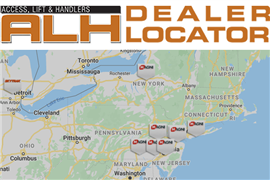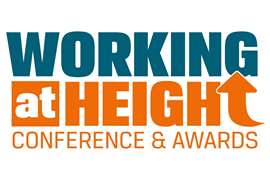Market report: Mast climbers and hoists
08 August 2022
The construction industry is on the brink of significant change and disruption. As the world continues to adjust and recover from Covid-19’s impact, it now also faces a multitude of pandemic-related macro-economic factors. Add to that the war in Ukraine, high inflation, interest rate rises, supply chain challenges, increase wage costs and reduced skilled labor availability… and the picture becomes a bit darker.
Yet, for the most part, construction work has continued – even if at a reduced rate – and across North America, demand for mast climbing work platforms (MCWP) and hoists has improved since the darkest days of the pandemic.
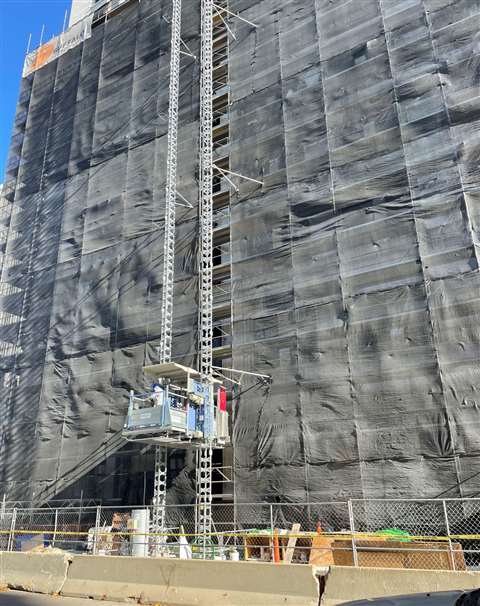 (Photo: GEDA)
(Photo: GEDA)
Prior to the pandemic, MCWPs and hoists were experiencing a surge in utilization on jobsites as contractors began to realize the units’ flexibility and benefits. This increase in use and acceptance eventually translated into new types of applications and markets, thus bringing on a “second wave” of demand.
“MCWP products are seeing an expansion in applications and how they are used,” explains Kevin O’Shea, chairman of IPAF’s International Mast Climbing Work Platform Committee. “These include multiple mast applications, chimney stack demolition, cooling tower maintenance, complex industrial work in hazardous environs, nuclear power station construction and so on. MCWPs seem to be more and more popular in these more complex, technically demanding applications, and this has vastly improved the perception of the product, and the supplier, as more of a high-value specialist bringing expertise and novel problem-solving ability to the job.”
ALH sat down with more than a dozen hoist and MCWP manufacturers, suppliers and dealers to get their pulse on not only product innovations, but the market and its related challenges and how they see the coming year shaping up. Here’s what they had to say.
ALH: What challenges is this sector currently facing?
Cameron Reid, sales director - construction division, Alimak Group: Improving the logistical vertical transportation requirements on a project to move personnel, materials and equipment is becoming more and more a need for all clients, developers, planners and contractors in the construction industry as they all driver greater level of sustainability and efficiency. We are encountering more and more complex facade modules, modular building units, prefabricated pods, heavy plant, heavier facades, etc., that are driving [us] to develop new accessories, applications and vertical access solutions.
William Lederman, general manager, mast climber division, Marr Scaffolding Company: Continued consolidation of companies in the construction rental business. Larger companies are buying out smaller companies to gain immediate presence in the local market. This saves time and money for the larger companies, which would have to buy or rent buildings and start their brand recognition from the ground up. Acquisitions into a local market allows the larger company to retain staff that knows the market and creates immediate profits with limited transition costs.
Johann Sailer, managing partner, GEDA: The current situation between Ukraine and Russia is omnipresent and probably affects most industries. The impact of the rising energy costs will also continue to be an issue. Of course, this industry also faced great challenges brought about by the coronavirus pandemic. A sophisticated digitalization had to be implemented and applied throughout the company very quickly. It had to be ensured, though, that good, longstanding business relations did not suffer and were maintained. Supply bottlenecks for raw materials are another burning issue faced by the industry. Thanks to forward-looking entrepreneurial action, we were always able to deliver and ship products to customers as quickly as possible.
Corinne Dutil, sales director, Fraco Products Ltd: First, there is the lack of labor. “The construction industry will need to attract nearly 650,000 additional workers on top of the normal pace of hiring in 2022 to meet the demand for labor, according to a model developed by Associated Builders and Contractors.” This has caused a hurdle for general contractors and builders. They sometimes have to refuse jobs because they do not have the team to accomplish it. The use of mast climbers and hoist is advantageous in this situation, because if teams are smaller when starting a project, these units increase productivity, speed, but also, satisfaction of the workers. But we haven’t seen a rise in the use of equipment on jobsite in the past two years though, which is related to another trend...
The rental prices of MCWP and hoists are the biggest challenge we are observing for this sector. With inflation being this high, people are turning to rental solutions for their projects. But with the rental prices staying low, it makes it impossible for dealers with fleets to evolve in the same pricing rise as the rest of the world. The industry needs to mobilize itself so that rental prices are fair on the markets, and pricing of new equipment. There are no reasons for rental prices to diminish when the equipment cost 20 percent more than it did 2 years ago. Keeping prices low in rental markets is a danger to this sector and key players of the industry must work together to offer prices that reflect the reality of the market.
Additionally, inflation has been affecting everyone. With material, labor, shipping, and basically all prices skyrocketing, equipment manufacturers have had to adjust their prices to reflect this new reality. For a fleet owner with equipment in his yard, the logical decision is to utilize his equipment before purchasing a machine that is much more expensive than it was 2 years ago. But the biggest problem we are observing is that while cost of equipment has gone up, rental prices haven’t. It is a big industry problem, because it makes it impossible for a fleet owner to have a profitable ROI and reinvest in their business when rental prices are being kept down.
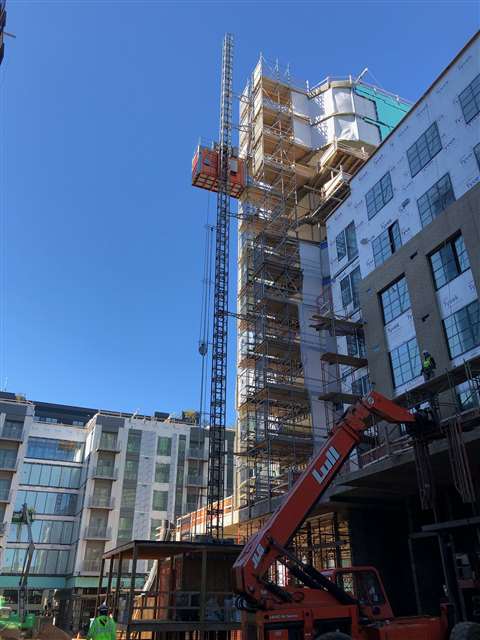 (Photo: Millstone Companies)
(Photo: Millstone Companies)
John R. Miller, president/CEO, The Millstone Companies: As with the construction industry in general, hoist and access companies continue to struggle with a lack of available craftsmen to replace an aging workforce in hopes of sustaining the industry.
Kevin O’Shea, chairman of IPAF’s International Mast Climbing Work Platform Committee: Like many other post-pandemic industries we have a major shortage of trained, qualified personnel. Young people don’t see our industry as a viable career path, although those who have entered the MCWP world will testify to the fact that it is a great industry to be in, with the vast majority staying in the industry over many, many years. Finding a way to attract and keep young talented people in the MCWP industry will be a major focus for years to come.
Michael Naglieri, outside sales rep, Lynn Ladder & Scaffolding: The biggest challenge that I am seeing with my customers is the supply chain issue; they are having a lot of delays with materials which causes jobs to be put off longer than original start date. We will have delivery schedules for our MCWPs but will then have to reschedule because of jobsite delays. However, the customers that use our MCWPs are happier than ever and are seeing the value of these units and how much productivity they are getting which makes them more profitable.
Eric Schmidt, P.E., regional sales manager, Century Elevators: Maintaining a skilled workforce in the current tight labor market has been and continues to be a real challenge. Providing local service for equipment on projects can be key to keeping reliability at a consistently high level. With interest rates rising and potential disruption in the housing market, we are experiencing concerns that some projects will be held back and delayed, or cancelled for the foreseeable future.
Nationwide, equipment companies have seen a decrease in the number of large, multitrade projects beginning the construction process. More of these large projects have been completed during this period, with fewer projects kicking off construction. Covid caused many project delays and uncertainty in the market, along with a decrease in available skilled labor for all aspects of construction, and disruption in supply chain and shipping. Project financing was heavily affected.
ALH: How is the overall market fairing for this equipment?
Miller: Mid-Atlantic region currently still seeing growth but clouds on the horizon. Fleet owners have excess inventory in markets growing cautious which is leading to reduced rates. Commercial slowing while residential is rising. In many cases, planned commercial construction has been/and is being converted into residential.
O’Shea: In general, we are all busy, and it’s a competitive world out there – and it seems more so than pre-pandemic. In North America, the traditional bastion of the heavy-duty MCWP – the brick and block industry – is still working well. There is way more product pick-up by major GCs than previously. More GCs are bring in MCWPs under their auspices in a ‘total envelope management’ process where the GC will provide, and schedule, all the required façade access for its sub-contractors.
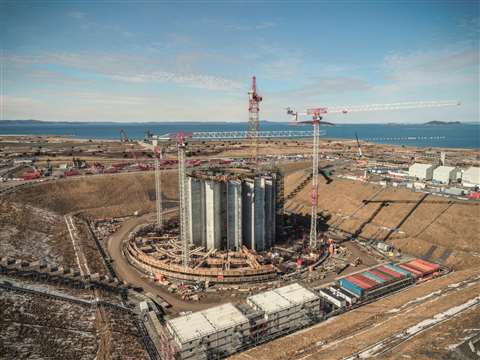 (Photo: Fraco Products LTD)
(Photo: Fraco Products LTD)
Dutil: We are observing a stable market with no growth at the moment. What is interesting is that there are many new materials being use in construction, and that creates new markets for MCWP/Hoist to be used in. New types of application create various opportunities.
In terms of regions, Miami, Austin and Tennessee are busier than ever. We are noticing that with the political situation in the U.S., there has been a lot of mobility in the market and these three cities, amongst others, have seen a humongous growth in construction. In NYC, there are less union jobs than before, which opens doors. On the West Coast, there was a concrete strike, which created a slowdown in the construction sector. And in Canada, we have observe a stable growth in regards to the need of equipment, but like everywhere else, there are more demands for rental solutions than before.
Schmidt: MCWPs and construction hoist systems have remained key to many projects in areas of the country experiencing strong construction markets – the Pacific Northwest, Arizona, Texas, Florida and northern Virginia. The masonry industry continues to maintain a strong demand for the heavier MCWP models, while demolition and renovation trades have seen a move to utilizing some of the lighter platform equipment on a wide range of projects.
Phil Cherrico, sales manager – North America, Zoomlion Heavy Equipment NA:. Zoomlion is launching in North America at the end of 2022/beginning of 2023. We have spent the last year researching industry trends and identifying some key areas where we can improve on what’s currently available to the market. Zoomlion plans on an “evolution” not a “revolution” of the models we’ve had a tremendous amount of success with internationally, with design features based on feedback from U.S.-based partners for North America.
Reid: The hoist sector in general is strong and we are seeing a resurgence following the pandemic especially in regions that were in lock down for longer than others. The MCWP sector is similar albeit there are differing levels of maturity within the industry around the world. The transport platform sector is seeing increased levels of demand as the need for larger, faster and greater capacity transportation needs are realized.
Sailer: From our point of view, we would describe the development of the overall market as very positive. Despite the coronavirus pandemic, we were able to achieve a good turnover and expect this continue for the foreseeable future. We can also report good success in all regions. Of course there are regions that stand out. The East Coast, for example, is an extremely strong region that generates a lot of turnover.
ALH: How do you see the upcoming 12 months fairing for the industry?
Geoff Blackwell, owner, Northern Mast Climbers: I expect that demand continues over the next 12 months based on proposal activity and pre-awarded projects. The economy could change climate at any time, to the upside or to the downside…
Cherrico: Zoomlion estimates that the hoist market will increase steadily over the year, with a more substantial increase in 2023 as supply chain challenges are overcome, then flattening. This of course depends on a number of socio-economic factors that may be fluid over the coming months.
Dutil: It’s been incredibly hard to predict the market. We have some jobs that have been on the books for 6 months that still haven’t been signed, while we sometimes get an order for four MCWP out of the blue. It’s been a challenge, and the key is flexibility. Because we don’t know how exactly this market will react to talks of recession, we need to stay agile and flexible, in order to best serve our customers.
The rental market will be very good, so for anyone that was thinking of embarking on such a project, it could be a good moment to make the investment. Meanwhile, equipment sales will be extremely dependent of the interest rates in the markets.
Barney Hanna, owner, Hanna Group, LLC: Overall,the market for MCWPs is growing. Many contractors are going through the learning curve, but once they use the equipment, they find additional jobs to use MCWPs. Hoists are also growing in popularity. Not only do they save time, money and labor, they also get materials and workers to the upper floors quickly and efficiently. You are seeing more buildings over five stories utilizing hoists. I think the market will continue to grow as more contractors are exposed to MCWPs and hoists. I don’t see any industry disruption, everyone I have spoken with is having a good year, especially after 2020.
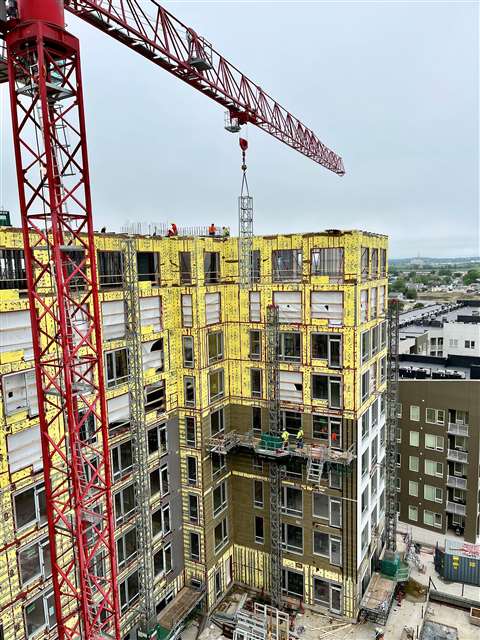 (Photo: Marr Scaffolding Company)
(Photo: Marr Scaffolding Company)
Lederman: I think a slowdown caused by inflation will eventually hurt the market, but I do expect the next two years to be robust as bidding and awards should continue to be at a feverish pitch well into 2024.
Sailer: We currently have a very positive outlook for the next 12 months. There are some industries where we want to gain a stronger foothold. We still see great potential there and want to pursue this increasingly. We want to focus on the oil and gas industry, for example, and on the industrial sector. We will drive these forward and strengthen them.
Miller: I expect a slowdown in 2023 but not a recession. New construction may slow but the renovation/restoration markets will pick-up as a result. Residential construction still strong with an emphasis on affordability. Workforce development within the construction industry need be the primary focus as it directly affects long-term sustainability.
O’Shea: While most are forecasting a soft-ish second half of 2022, a main focus of the industry right now is what does Q1 and Q2 look like in 2023? A ‘successful’ year in the MCWP industry usually begins with a fast-paced new year demand. The number of new projects that are set to commence in Jan/Feb 2023, how early in the year they will require equipment on site, winning the Sep-Dec supply contracts for the early new year commencement and finding and training labor to perform the installation and maintenance of the MCWP equipment will be key.
The possible softening of the market and a pronounced labor shortage will, I think, occupy the minds of MCWP companies for the remainder of 2022.
Reid: Various regions around the world will be affected by political, economic, sociological, technological, legal and environmental factors; however, for mature strong and resilient brands such as Alimak that have a focus on continuous improvement, high quality, sustainability, providing the best solutions, service, technology and digitalization; we expect to grow our position in the market. We will continue to develop new products, services and solutions; and we fully expect these products to be well received by the market and our customers.
ALH: What design or engineering changes have been implemented into units over the last two years? Why?
Sailer: In the U.S., we sold our first Multilift P18 Premium during this period. The passenger and material hoist with the Premium Package has some unique features and was very well received in the U.S. The GEDA Multilift series was introduced in 2007 and was completed with this market launch. The innovative mast technology of the GEDA-UNI-X-MAST system, extensive control options, a clean design and the possibility of remote service are only some of the advantages which make this passenger and material hoist a highly versatile unit for construction sites.
We are also pleased that we can now present the technical possibilities of the GEDA devices on our in-house test tower, allowing customers and other interested parties to see the hoists in action. Technical training has also become a focal point and has a high priority.
There have also been some improvements in the electrical systems of our devices. Using the hoists has never been this efficient and easy. This makes them particularly attractive for plant hire companies and many are expanding their range.
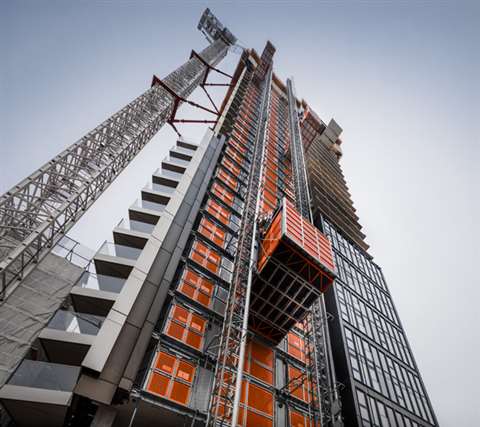 (Photo: Alimak)
(Photo: Alimak)
Reid: Alimak’s R&D and product management team continue to work on developing improvements across the current light, medium and heavy-duty product range in both MCWP and Hoists. They are also working hard in the background on developing new products that meet the sector and customers needs. Our R&D team have also been working on the ‘My Alimak’ digital on-line platform that includes portal access for our customers to manage their assets. The assets are connected on-line and provide data on use and logistical characteristics. There are various pages within the portal providing AliCalc calculation tools, digital manuals, service information, fleet management and a fully integrated BIM library.
Lederman: Marr has been at the forefront of safety and training for mast-climbers from its original agreement with Hydro-Mobile and through its own commitment to safety. The major improvement that Marr/Hydro-Mobile made was to centralize an information center that tracks all personnel that have been trained and on what specific units they were trained on. We can verify training and prevent untrained personnel from working on the units.
Dutil: We are currently working on design changes on our MCWP/hoist units but cannot yet disclose them. But, in the last two years, we have focused on two new products that were added to our product line: the FMC-3, our newest MCWP, and the PL-15, a light-weight transport platform.
The FMC-3 is the perfect access solution for light construction and restoration. This work platform distinguishes itself by its great adaptability, thanks to the built-in floor extensions of progressive lengths that allow an extension of the working area of up to 6 feet, 4 inches. For safety, these extensions can be locked and are provided with a non-slip material to avoid accidental falls. The FMC-3 uses a reliable and proven rack and pinion lift system. It is equipped with a Honda gasoline engine or with Weg electrical motors, as well as a safety device system.
The Torgar PL-15 EXT transport platform distinguishes itself by its ease of installation and operation. It is also the most cost-effective vehicle to transport subcontractor workers and material such as metal framing and finishing, doors and windows, HVAC and plumbing, electrical, etc. With an interior length of more than 13 feet, the elevator allows the transport of drywall panels of different dimensions. It can also be used for debris removal. Designed for the hardest working conditions, the PL-15 EXT requires a minimum maintenance and is reliable and versatile. It includes several long lasting and safety features such as an emergency brake installed on an independent pinion; tube and clamps wall ties; a lateral side loading access and a base mounted on wheels and leveling spindles.
Miller: Product engineering continues to improve with an emphasis on fleet owners’ return on investment. It has become more about engineering the hoist system to fit the building as building design has created more applications involving backstructures, common platforms and other setback solutions.
MAGAZINE
NEWSLETTER
The gold standard in market research
Off-Highway Research offers a library of more than 200 regularly updated reports, providing forensic detail on key aspects of the construction equipment industry.
Our detailed insights and expert analyses are used by over 500 of the world’s largest and most successful suppliers, manufacturers and distributers, to inform their strategic plans and deliver profitable growth.




